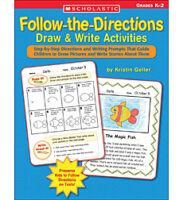When the kindergarten teachers at Julie Ballew’s school gave each student a reader’s notebook, everyone was impressed with how much the young students had to share. If you’re interested in using prompting — or, introductions to a writing topic — in your own classroom, here are Ballew’s top tips on how to encourage young students to respond to their reading in meaningful ways. With proper guidance and prompting, even the youngest readers can become independent writers!
Teachers of young writers need to set expectations by modeling reader’s notebook entries that are completed together, using books covered during read-aloud or shared-reading sessions. By clearly modeling these entries, you will help students gain a strong understanding of the kinds of responses that can go in their reader’s notebooks.
Be sure to display enlarged examples of your modeled entries to your class. Give your students possible sentence stems to talk about the connections they are making. Point out each part of your modeled entry and work with your students to create their own.
At first, drawing pictures may be more important to your students than writing words — and that’s okay! Learning to represent their thinking through pictures will support their ability to express themselves in written words later.
Independent writing won’t happen overnight, as students will have to build towards it. After a few weeks of modeled writing, encourage your students to take their notebooks with them to their literacy stations.
You should anticipate that there will be some challenges as students start writing on their own. They may write in the notebook upside down or backwards, scribble a tiny bit on five different pages, or accidentally tear out pages, no matter how careful you tell them to be. And that’s okay, too! To become independent at anything, students need opportunities to practice and permission to mess up.
You may see a wide range of quality in your students’ independent responses. Many students will build a habit of drawing before writing, and they may start an entry by drawing a character from their story before writing a sentence about their favorite part. But if you find some students are struggling to write anything at all, this is where prompting really comes in handy.
Writing prompts will help students make connections to their reading as they think about how they want to respond in their notebooks. When they are ready to turn their thoughts into words, they will write without hesitation, and often with clear and concise words that match the prompt card.
Here are sample prompts to get students thinking:
- Talk about your favorite part.
- Retell the beginning, middle, and end.
- Make a connection.
- Who are the characters, and what do they do?
- Talk about the funniest part of the story.
- Find the word wall words in the book.
- Talk about some facts you learned in this book.
By following the steps above, you will give students opportunities to practice their independence, opportunities to be messy, and guidance to get better. This will undoubtedly lead to high-quality work in their reader’s notebooks.
Check out the books below for more writing prompts and resources for young writers.















